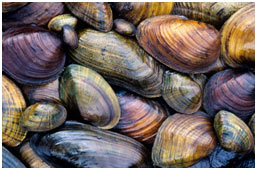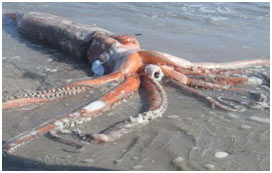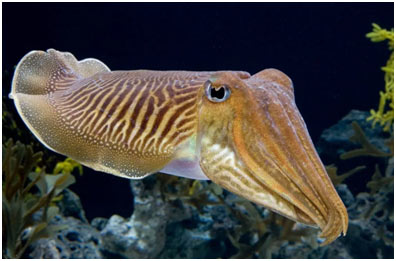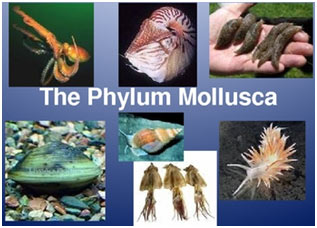Phylum Mollusca – Soft Animals
The word Mollusc stems from the Latin word “Molluscus” which means soft. It is the second-largest phylum of invertebrates; as the very first one is arthropods.
The phylum consists of soft-bodied animals. The phylum Mollusca consists of a diverse group of organisms which include slow-moving snails and slug, bivalved clams, and highly active cephalopods. The phylum consists of over 50,000 living species.
- 1) General Characteristics of Phylum Mollusca
- 2) Reproduction in Phylum Mollusca
- 3) Classification of Phylum Mollusca
- 4) Economic Value of Mollusca
- 5) FAQs about Phylum Mollusca
- 6) Multiple Choice Questions (MCQs) about Phylum Mollusca:
- 7) Summary: Phylum Mollusca – A Dive into Soft Animal Diversity
- 8) You may also like to learn:
General Characteristics of Phylum Mollusca
Grade of Organization
Molluscs are triploblastic coelomates which show bilateral symmetry. Molluscs likewise show a great variety of body form however all are built on the same basic plan.
Habitat: Molluscs are commonly widespread. Some groups are solely water living (e.g., Cephalopoda), freshwater or marine. The others consist of terrestrial animals (land snail) living mostly in damp places.
Shells
Most animals possess a shell. The body is covered by a glandular epithelial envelope called mantle which produces calcareous shell. The shell is protective, but it is a handicap to mobility, for that reason, a few of the active molluscs show a decrease or loss of shell.

Body structure
The body is unsegmented and soft. The body can be divided into head, a ventral muscular foot and a dorsal visceral mass consisting of the majority of the internal organs. Over the visceral mass, mantle exists which secretes a shell. The space between the shell and mantle cavity includes gills in some animals. In the mouth cavity of many molluscs, there is a wearing tongue-like radula provided with many spiny teeth.
Do you know???
The giant squid is the biggest invertebrate animal.
Organs and Organ Systems
The body is extremely arranged with complicated digestion, respiratory, circulatory, excretory, nervous and reproductive systems.

Nervous system
The nervous system consists of three sets of interconnected ganglia present in the head, foot and body areas.
Breathing system
The gaseous exchange is by gills mostly. Sometimes such as snail, the mantle cavity is converted into a lung.
Circulatory system
Except for Cephalopoda, the circulatory system is open. The coelom is divided into sinuses or blood spaces. The heart pumps the blood into the sinuses. A breathing pigment of blue in color, called haemocyanin exists.
Digestive system
The digestion system includes the gut with two openings, the mouth and the anus.
Excretory system
The excretory organs are paired nephridia.
Mobility and organ for locomotion
The organ of locomotion is a muscular foot, however, in many types the movement is sluggish. The others are sessile i.e. unable to move.
Reproduction in Phylum Mollusca
Sexual Reproduction: The sexes are separate.
Life cycle: Trochophore larva develops throughout embryological development.
Classification of Phylum Mollusca

The molluscs are classified into six classes. The significant classes are:
(i) Gastropoda
These are asymmetrical and their body is covered with typically coiled one piece shell. The animal can withdraw itself into the shell. Both aquatic and terrestrial types are consisted of in this class. The marine types have gills while in landforms the mantle cavity is converted into lungs.
The typical examples are:
i. Helix aspersa: The garden snail.

ii. Limax the slug

(ii) Bivalvia (Pelecypoda)
This class includes bilaterally symmetrical aquatic molluscs. The body is laterally compressed and is enclosed by two pieces of shells, for this reason, the name bivalves. They respire by plate-like gills.
The typical examples are:
i. Mytilus: marine mussel.

ii. Anodonta: freshwater mussel.

iii) Ostrea: the oyster.

(iii) Cephalopoda
The members of this class are bilaterally in proportion with a dorso-ventrally flattened body. All species are marine. The shell is much minimized and internal. In many cases it is absent. The animals are very much developed and active.
The common examples are:
i. Loligo: (squid).

ii. Sepia: (cuttlefish)

iii. Octopus.

The brain of octopus is exceptionally large and complex for an invertebrate brain. It is confined in a shell-like case of ‘Cartilage’, and endows the octopus with highly established capabilities to learn and remember. In the laboratory, the octopus can quickly learn to associate specific signs and can open a screw cap jar to get food.
Economic Value of Mollusca
Some molluscs are indirectly harmful to man but most of them are beneficial. The damaging molluscs are slugs and shipworms. Slugs are injurious to gardens and crops and plantation. They not only eat leaves but also damage plants by cutting their roots and stems. Teredo, a shipworm damages wood parts of ships. But lots of molluscs are a fantastic source of food for people in many parts of the world.
Large amounts of clams, oysters and mussels are eaten in Far-east, Europe and America. Oysters are regarded as special. Shells of freshwater mussels are used in the button industry. Likewise, shells of oysters are combined with tar to make roads in America. Shells in particular parts of the world are also utilized for making accessories. Some oysters likewise make valuable pearls e.g. the pearl oyster.
FAQs about Phylum Mollusca
Q1: What does the word “Mollusc” mean, and why is the phylum called so?
A1: The term “Mollusc” is derived from the Latin word “Molluscus,” which means soft. The phylum is named for its soft-bodied organisms.
Q2: How diverse is the phylum Mollusca, and what types of organisms does it include?
A2: Phylum Mollusca is highly diverse, encompassing slow-moving snails, slugs, bivalved clams, and active cephalopods. It boasts over 50,000 living species.
Q3: What is the largest invertebrate animal, and which phylum does it belong to?
A3: The giant squid holds the title of the largest invertebrate animal and belongs to Phylum Mollusca.
Q4: What are the general characteristics of organisms in Phylum Mollusca?
A4: Molluscs are triploblastic coelomates with bilateral symmetry. They exhibit a variety of body forms but share a common basic plan.
Q5: Do all molluscs have shells?
A5: Most molluscs possess shells, which are produced by a glandular epithelial envelope called the mantle. However, some active molluscs may show a reduction or loss of the shell.
Q6: What are the major organ systems in molluscs?
A6: Molluscs have highly organized digestive, respiratory, circulatory, excretory, nervous, and reproductive systems.
Q7: How do molluscs breathe, and what pigment is involved in their circulatory system?
A7: Gaseous exchange is primarily through gills, and the circulatory system, except for Cephalopoda, is open. The pigment involved is haemocyanin, which imparts a blue color.
Q8: How do molluscs reproduce, and what is unique about their life cycle?
A8: Molluscs reproduce sexually, with separate sexes. Their life cycle involves a Trochophore larva developed during embryological development.
Q9: What are the major classes in Phylum Mollusca, and can you provide examples?
A9: The major classes include Gastropoda (e.g., garden snail), Bivalvia (e.g., marine mussel), and Cephalopoda (e.g., squid, cuttlefish, octopus).
Q10: What economic value do molluscs hold for humans?
A10: Molluscs are a significant food source globally, with clams, oysters, and mussels being consumed widely. Additionally, shells are used in industries such as buttons and road construction, and some oysters produce valuable pearls.
Multiple Choice Questions (MCQs) about Phylum Mollusca:
1. What does the term “Mollusc” mean in Latin?
- A. Hard
- B. Soft
- C. Shell
- D. Fast
Answer: B. Soft
2. Which phylum is the giant squid, the largest invertebrate animal, a part of?
- A. Arthropoda
- B. Mollusca
- C. Annelida
- D. Cnidaria
Answer: B. Mollusca
3. How many living species are estimated to be in Phylum Mollusca?
- A. Over 10,000
- B. Over 30,000
- C. Over 50,000
- D. Over 100,000
Answer: C. Over 50,000
4. What is the primary function of the mantle in molluscs?
- A. Locomotion
- B. Digestion
- C. Shell production
- D. Sensory perception
Answer: C. Shell production
5. Which class of molluscs is asymmetrical and often has a coiled shell?
- A. Gastropoda
- B. Bivalvia
- C. Cephalopoda
- D. Polyplacophora
Answer: A. Gastropoda
6. In which habitat are some molluscs exclusively water-living?
- A. Terrestrial
- B. Marine
- C. Desert
- D. Rainforest
Answer: B. Marine
7. What is the pigment responsible for the blue color in the circulatory system of some molluscs?
- A. Hemoglobin
- B. Hemocyanin
- C. Melanin
- D. Chlorophyll
Answer: B. Hemocyanin
8. What is the primary organ of locomotion in molluscs?
- A. Tentacles
- B. Foot
- C. Fin
- D. Wing
Answer: B. Foot
9. Which class of molluscs includes bilaterally symmetrical aquatic organisms with a compressed body enclosed by two shells?
- A. Gastropoda
- B. Bivalvia
- C. Cephalopoda
- D. Polyplacophora
Answer: B. Bivalvia
10. What type of larva develops during the embryological development of molluscs?
- A. Plankton
- B. Trochophore
- C. Nymph
- D. Pupa
Answer: B. Trochophore
11. What is the primary economic value of freshwater mussel shells?
- A. Jewelry
- B. Button industry
- C. Construction material
- D. Currency
Answer: B. Button industry
12. Which mollusc is known for producing valuable pearls?
- A. Garden snail
- B. Marine mussel
- C. Squid
- D. Octopus
Answer: B. Marine mussel
13. What is unique about the nervous system of molluscs?
- A. It has one ganglion
- B. It is absent
- C. It has three sets of interconnected ganglia
- D. It is located in the tentacles
Answer: C. It has three sets of interconnected ganglia
14. Which organ is converted into a lung in some molluscs, such as snails?
- A. Gills
- B. Mantle cavity
- C. Heart
- D. Foot
Answer: B. Mantle cavity
15. What class of molluscs has a highly developed and active lifestyle with a much-reduced or absent shell?
- A. Gastropoda
- B. Bivalvia
- C. Cephalopoda
- D. Polyplacophora
Answer: C. Cephalopoda
Summary: Phylum Mollusca – A Dive into Soft Animal Diversity
Phylum Mollusca, derived from the Latin term “Molluscus” meaning soft, constitutes the second-largest invertebrate phylum. Comprising over 50,000 living species, this diverse group includes slow-moving snails, slugs, bivalved clams, and highly active cephalopods.
The overview explores the general characteristics of Molluscs, emphasizing their triploblastic coelomate nature with bilateral symmetry. It sheds light on their habitat diversity, from water-dwelling Cephalopoda to terrestrial land snails. The protective shells, created by a glandular mantle, are discussed, noting variations in shell presence among active molluscs.
Delving into body structure, the unsegmented and soft bodies are divided into a head, ventral muscular foot, and dorsal visceral mass with accompanying mantle and gills. The intricate organization of organ systems, including digestion, respiration, circulation, excretion, nervous, and reproductive systems, is explored.
The classification into six classes, with a focus on Gastropoda, Bivalvia, and Cephalopoda, highlights unique features and examples. The reproduction process, showcasing separate sexes and a trochophore larval stage, adds to the phylum’s complexity.
Closing with the economic significance, the summary notes both harmful aspects, such as slugs damaging crops, and beneficial roles, including the consumption of clams, oysters, and mussels worldwide. The multifaceted uses of mollusc shells, from industrial applications to the creation of valuable pearls, underscore the ecological and practical importance of Phylum Mollusca.

